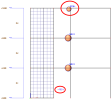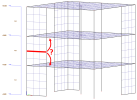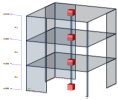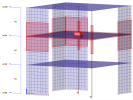Validation of modal analysis: specifics for IRS analysis
Dynamic analysis troubleshooting > modal analysis > specifics for IRS analysis
Up to this point, the described validations are relevant for any dynamic analysis. Once that is done, some points can be refined specifically in the case of seismic analysis.
Specific checks of modal analysis for IRS analysis
This section gives a few hints about mass validation when using improved reduced system analysis.
For more details, see also the following chapters:
- Theoretical background: "Reduced Analysis Model"
- Good practices: "When should IRS analysis be used (or not)?"
about the number of modes that must be taken into account for seismic analysis.
Distribution of masses in the reduced system
The reduced system is generated from the "Storeys" definition of the model. By default, a reduction node is placed at the base of each storey on a vertical axis at the geometric center of the model.
Each node of the finite element mesh is mapped and reduced to the closest reduction node.
Based on that principle, both the stiffness matrix and the mass matrix of the initial FE mesh are reduced to the corresponding reduction node.
That simple principle has several consequences:
- The mass of any storey (i.e. the mass of the corresponding reduction node) include typically the deck of that storey and half of the supporting members below and above the deck.
- The mass center of the top storey of any building is typically located slightly underneath the top deck (see picture below).

- For seismic analysis, the bottom storey is often modelled without its foundation slab. All supporting members are directly connected to supports. As a result, the bottom reduction node corresponds to the bottom half of the supporting members of the bottom storey and its mass center is located at approximately 1/4 of the storey height (see picture above).
IRS analysis requires that all reduction nodes are associated with some mesh nodes and have a non-zero mass. Make sure that the supporting members of the bottom storey are sufficiently meshed, so that at least one row of unsupported mesh nodes can be associated to the corresponding reduction node.
Please note, that support nodes are ignored in dynamic analysis, as their mass cannot move. A non-associated reduction node will make the IRS analysis fail. Typically, this may be an issue when the supporting system is made only of 1D members, as no mesh refinement is required by default.
- In case the mesh subdivision of supporting members is even, the mesh nodes at mid height of the storey may be associated either to the upper or lower reduction node. This may lead to slight irregularities in storey masses.

Next step: validation of seismic analysis


